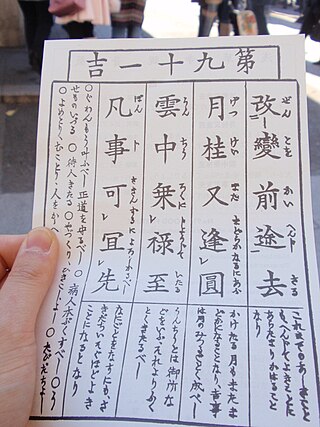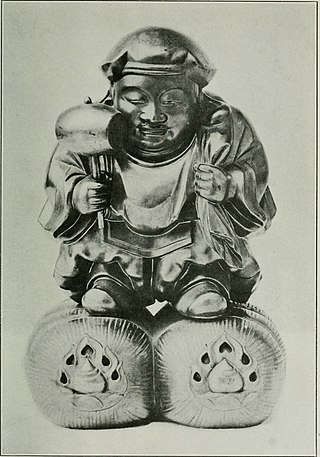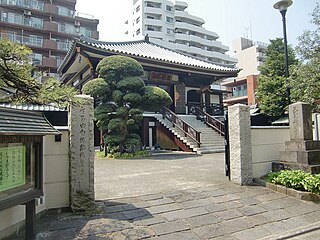
Kyoto, officially Kyoto City, is the capital city of Kyoto Prefecture in the Kansai region of Japan's largest and most populous island of Honshu. As of 2020, the city had a population of 1.46 million, making it the ninth-most populous city in Japan. More than half (56.8%) of Kyoto Prefecture's population resides in the city. The city is the cultural anchor of the substantially larger Greater Kyoto, a metropolitan statistical area (MSA) home to a census-estimated 3.8 million people. It is also part of the even larger Keihanshin metropolitan area, along with Osaka and Kobe.

Asakusa is a district in Taitō, Tokyo, Japan. It is known for the Sensō-ji, a Buddhist temple dedicated to the bodhisattva Kannon. There are several other temples in Asakusa, as well as various festivals, such as the Sanja Matsuri.

Takarazuka is a city located in Hyōgo Prefecture, Japan. As of 1 February 2024, the city had an estimated population of 221,846 in 96,729 households and a population density of 2,200 persons per km². The total area of the city is 101.80 square kilometres (39.31 sq mi). Known as the "inner parlor" of Kansai, Takarazuka is famous for the Takarazuka Revue, hot springs, and the Takarazuka Tourism Fireworks Display held since 1913. It is also famous as a choice residential area along with Ashiya and Nishinomiya.

The maneki-neko is a common Japanese figurine which is often believed to bring good luck to the owner. In modern times, they are usually made of ceramic or plastic. The figurine depicts a cat, traditionally a calico Japanese Bobtail, with a paw raised in a beckoning gesture. The figurines are often displayed in shops, restaurants, pachinko parlors, dry cleaners, laundromats, bars, casinos, hotels, nightclubs, and other businesses, generally near the entrance, as well as households. Some maneki-neko are equipped with a mechanical paw which slowly moves back and forth.

Omikuji (御御籤/御神籤/おみくじ) are random fortunes written on strips of paper at Shinto shrines and Buddhist temples in Japan. Literally "sacred lot", these are usually received by making a small offering and randomly choosing one from a box, hoping for the resulting fortune to be good. As of 2011, vending machines sometimes dispense omikuji.

Daikokuten is a syncretic Japanese deity of fortune and wealth. Daikokuten originated from Mahākāla, the Buddhist version of the Hindu deity Shiva, conflated with the native Shinto god Ōkuninushi.

Sensō-ji, is an ancient Buddhist temple in Asakusa, Tokyo, Japan. It is Tokyo's oldest-established temple, and one of its most significant. It is dedicated to Kannon, the bodhisattva of compassion. Structures in the temple complex include the main hall, a five-story pagoda and large gates. It is the most widely visited religious site in the world with over 30 million visitors annually.

Zōjō-ji (増上寺) is a Jōdo-shū Buddhist temple in Tokyo, Japan. It is the main temple of the Jōdo-shū Chinzei sect of Buddhism in the Kantō region,. Its mountain name is San'en-zan (三縁山).

Aya Ueto is a Japanese actress, singer and television personality. In 1997, Ueto participated in the seventh Japan Bishōjo Contest, where she won the special jury prize. Soon thereafter, Ueto joined the talent agency Oscar Promotion and began taking singing, dancing and acting lessons. In 1999, she formed the girl group Z-1 with three fellow Japan Bishōjo Contest participants. The group disbanded in 2002 and later that year, Ueto signed with Pony Canyon and released "Pureness", her debut single as a lead artist. She has since released five studio albums which have spawned ten Oricon top-ten singles.

Renkō-ji is a Buddhist temple in Tokyo, Japan. It is assumed to be the purported location of the ashes of Netaji Subhas Chandra Bose, Indian revolutionary, which have been preserved since September 18, 1945. The small, well-preserved temple was established in 1594 inspired by the God of Wealth and Happiness. It belongs to the Nichiren sect of Buddhism that believes that human salvation lies only in the Lotus Sutra.

Sanja Matsuri, or Sanja Festival, is one of the three largest Shinto festivals in Tokyo. It is considered one of the wildest and largest in Japan. The festival is held in honor of Hinokuma Hamanari, Hinokuma Takenari, and Hajino Nakatomo, the three men who established and founded the Sensō-ji Buddhist temple. Sanja Matsuri is held on the third weekend of every May at Asakusa Shrine. Its prominent parades revolve around three mikoshi, as well as traditional music and dancing. Over the course of three days, the festival attracts 1.5 to 2 million locals and tourists every year.

Taipei Japanese School (TJS) is a Japanese international school located in Shilin District, Taipei. TJS was established in 1947 and mainly serves the children of Japanese expatriates in Taiwan.

Beppu Daigaku Station is a passenger railway station located in the city of Beppu, Ōita Prefecture, Japan. It is operated by JR Kyushu.
The Escuela Japonesa de Panamá is a Japanese international school in the Marbella area, Bella Vista, Panama City. It was established on October 12, 1974.

Taichung Japanese School is a Japanese international school in Daya District, Taichung, Taiwan in the Republic of China.

The Textile Culture and Ukiyo-e Art Museum – Amuse Museum, or simply Amuse Museum, was a private museum specializing in Japanese textile culture and ukiyo-e. It opened on 1 November 2009 in Asakusa, Tokyo, not too far from Ueno Park, where multiple other museums are located. The museum was closed on 31 March 2019.














